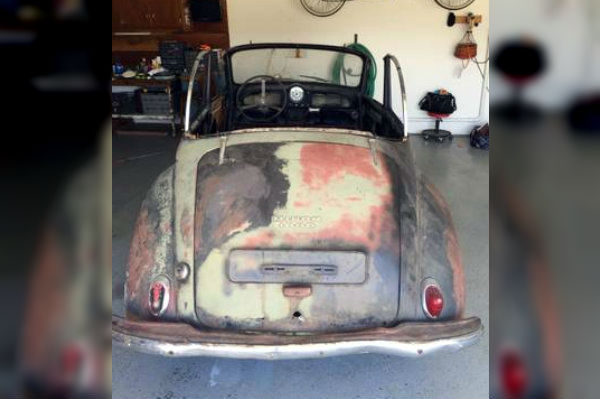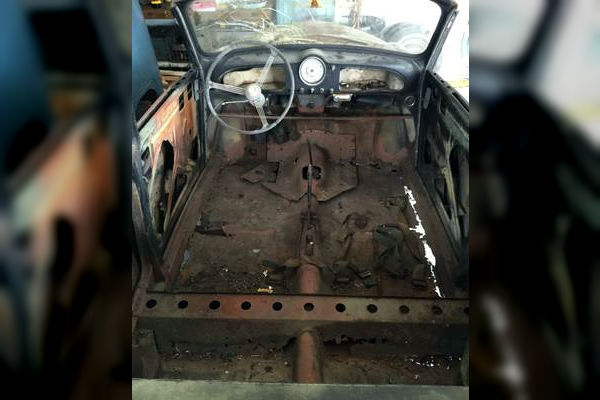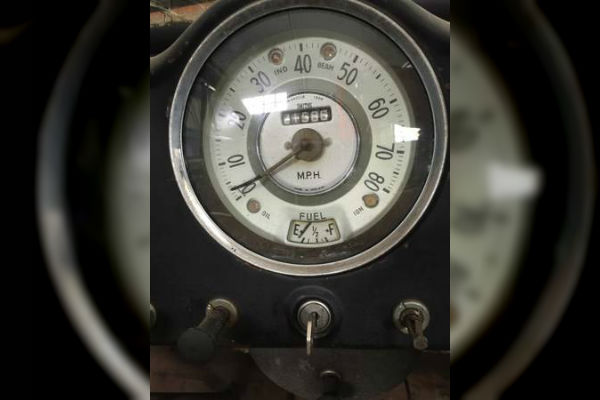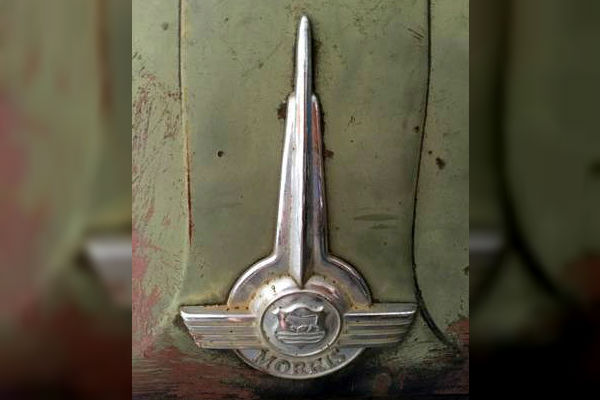From the town of Troy, Illinois is this 1959 Morris Minor convertible. It’s offered for sale here on craigslist with an asking price of $950. While this isn’t exactly the most viable project car we’ve ever featured here on Barn Finds, we see so few of these that we thought this one was worth mentioning. It’s one of those dirt cheap cars, incomplete and with no title.
As someone who knows very little about these, I find the body style interesting because it looks to have the proportions of a much larger car, scaled way down. Since plenty of the original bits are gone, it opens up lots of possibilities for modification or customization. I’m dreaming way out on a limb here, but what would it look like with a ’40 Chevy front end carefully grafted on? How about a Buick? Could it be successfully done in a way that would look natural and “right”? One thing is for sure, it would certainly aggravate some of the Morris faithful, no matter how rough this car is to begin with. Apart from any pie-in-the-sky ideas about this car, some of what’s here with it now is also worth noting.
The seller offers no information about the running condition of the drivetrain or much else, but the appearance of it in the photo, and the presence of a fairly recent-looking battery suggests this car may have been in some kind of semi-operable state not too long ago. That was probably just before the interior was removed to reveal the interior floor.
That floor is a jagged, rusty mess, but as with the Datsun roadster from a few days ago, it’s mostly flat, and fabrication of patches wouldn’t be impossible, if this car were worth doing. Although it does look exceptionally rough and anyone who would take it on as a project could expect to spend many hours doing that kind of work to it.
The instrument panel looks at least somewhat intact, including this attractive looking speedometer and fuel gauge. The car also sports a neat looking banjo steering wheel with an “M” logo in the center. Does that stand for Morris, or for Minor?
It also has this exterior trim emblem, which I would be sure not to leave out of any crazy customization plan.
With over a million and a half units made during a long production run, this car has been referred to as Britain’s Volkswagen Beetle. With a good four door parts car, this example is restorable, although I wouldn’t call it easy by any means. Or it could be the foundation for some radical customization. Is it worth saving? Either way, it’s time to let us know what you think.






These are wonderful little cars, easy to restore. Everything is readily available and it is a convertible. If it need an engine……a 1250 MG is a direct bolt in and a later synchro transmission would be nice. It seems to be missing the door window frames….they look better without them but the windows won’t work. This would be a great beginers car. Simple, classy, ease of parts and many experts around to lend assistance. Disc brake kits are also available. Fun little cars.
I have a 1250 eng and gear box fr a 65 Austin Healy for sale. $600 for both. Eng hasnt run in several years. Clutch went out and it got parked. Next thing I knew several yr’s went by
Located where?
Plant City Fl. Between Tampa and Orlando
You’d have to love it, because when you were done, you would not have much.
Getting rarer by the moment.
In a few years time this could be a quirky little, HIGH priced convertible.
It would be interesting to find out how many came to the States, and how many are still alive !
There is a pretty nice one on eBay right now that has been bid up to 8100.00, I think they are starting to move.
In my teens, a buddy had a Morris Minor convertible. His burned more oil than gas and had to be pushed to start it, but it was a hoot to take to the burger drive-in. We all had to pile out, push it across the lot until it fired and then dive in over the back. Made for some of the most fun evenings ever! I’ve seen them done up with restored bodywork, custom paint and with SBC’s and small block fords for power – a fantastic hotrod! A great project!
you are correct dave w. i have hever had one but have always thought one would be fun. i would love to have it, now that i know that a 12550 mg is a direct fit. i love a lot of the small british cars, but have always stayedaway because most often with the engines and trannys missing i never knew where to start being a novice mechanic it would be too much challange for me. i always wonder about drive shafts etc. at 70 and slowing down and downsizing these don’t take a lot of room and and you can easier work alone. i aquired a crosley sme time back for that reason. yu can walk around wth a tranny in one hand and probably install an engine easily. not bad price either with most there
Have a really good look underneath!
There were actually 56,000 Morris Minors exported to the U.S. from 1949 through 1967.
The design is somewhat like a late ’40s Buick, but stayed fundamentally the same from its 1948 launch through the end of the production in 1971.
It’s Britain’s VW Beetle in some ways, but a total of 1.6 million were made–which means you can get EVERY single part, including replacement floorboards. They’re dead easy to restore, very simple, and had superb handling for the day. They put a smile on peoples’ faces, and make very nice inexpensive collector cars.
More than half the Minors in the U.S. are two-door sedans, but there are also convertibles like this one, and Traveller woody wagons–Morris being the last company in the world to build cars with genuine ash wagon structures. (They’re likely to end up the most valuable.) The four-door sedans, pickup trucks, and vans are the rarest in the U.S.
I’ve had five Minors, still have our family Traveller (bought new in 1961), and ran the club for 10 years, so happy to answer more questions about Minors.
Thank you. Maybe my next project. I just bought the red Triumph Spit Fire 64 (in ppices) fr ebay and feature here adout a week ago. I’m an amature so it’s going to take alittle while to complete it.
So……..you are one of the experts that can help out beginners……great. I did a Morris convert like this one 3 1/2 decades ago but do not have your depth of expertness. I did the car for an old girlfriend, it was not rusted, just disassembled and missing the drivetrain. I drew on my experiance with minis and sprites. One of the reasons we liked the Morris is it had a real heater that was more reliable than the VW in the Utah winters.
Hi, I have a 1960 Morris Minor with a siezed 950 motor. i aquired a 1275 mgb motor, and wondering will the mgb motor bolt right in with no modifications? thank you kindly, bill
We had one of these as a kid, bright yellow. We stuffed in a Fiat twin cam and 5 speed which made it move right along. It was a really fun car and I wonder where it is now.
quite a few turn up at UK car shows with Buick/Rover V8 engines. There’s plenty of room under the hood, because Morris originall pl;anned to fit a Flat four engine.
The reference in the article to a “a good four-door parts car” is wrong, unfortunately. You’d want a two-door parts car because the doors are the same size.
Four-doors, along with pickups and vans, used shorter front doors that don’t fit two-doors, Travellers, or convertibles like this car.
Quite right! The Boss Man was not too happy spending money on developing a new Flat 4 engine (which was hoped to reduce bonnet line and improve aerodynamics), and insisted that the old side valve 803cc engine from the Morris 8 be utilised instead. Apparently, that is why the brake master cylinder is located below the driver’s seat?
@rogerowen Actually, Paul Skilleter’s seminal 1981 book, “Morris Minor: The World’s Supreme Small Car,” tells the story differently–based on interviews with designer Alec Issigonis and engineer Reg Daniels.
The assignment had been to design a car, not an engine as well. The Morris Engines branch in Coventry wasn’t keen on it. And in the end, the post-war Nuffield Organization simly didn’t have the money to develop two simultaneous models (Series MM Minor and Series MO Oxford) AND a new flat-four engine to boot.
That’s how the pre-war 918cc side-valve engine came to be used.
Someone mentioned a 1250cc engine? Not sure where that comes from (unless a much later British Leyland vehicle). Engines for the ‘Moggie’ (Morris Minor) where;
803cc (side valve)
948cc (OHV) – in my opinion the best!
1098cc (OHV) in the last models.
Midgets & Sprites started off with the 948 in the ‘Frogeye’ (‘Bug’ I think it’s called over there), followed by the 1098, and 1275 (nice engine that was a bit of a re-think for the final ‘A’ series). Then along came the Triumph 1500 engine for the final models. There was also a very fine 998cc engine along the ‘A’ series lines which was a development of the 850 that sat in the early Minis. Personally, I preferred the 850 – seemed nicely balanced. GOSH if your’e not bored – I am! Pass me that anorak please!
Errr, not quite!
918cc – Series MM pre-war side-valve
803 cc – Series II “A”Series
948 cc – Series III “A” Series (1957-62 Minor 1000)
1098 cc – Series V “A” Series (1963-71 Minor 1000)
Loads of U.S. Minors have been uprated using the 1275cc Spridget engine.
Not too sure that the 918 was fitted to the Morris Minor (as we know it) – 1948 onwards. But, could be wrong!
The 918cc side-valve was used on Minor two-doors and Tourers from 1948, and four-doors from 1950.
The BMC 803cc “A” Series engine, from the Austin A30, was fitted first to four-door export Minors from July 1952. Both engines were used until early 1953, when the 803cc was standardized–shortly followed by the launch of the two commercials and then the Traveller.
I stand corrected!
When I first went to, and lived in Sri Lanka, all taxis were black Morrises Minor. That was also true in Hong Kong.. In Sri Lanka, when I took a cab, I would ask the driver/owner how old his vehicle was. Typically, he would answer “24th of April 1948″ or whatever the vehicle’s date of manufacture was. By this time, Thatcher’s successive administrations had destroyed the British car industry, in the name of destroying the unions, so I asked where they got parts for their cars.”Singapore” was the answer. There were so many Morris Minors in use in South-East Asia that an industry had grown up in Singapore making parts for them.
India still makes all the parts for early Jeeps as well. I was a little disappointed to learn last fall while I was in the UK that all the great little “London Taxies” are now made Orient. They seem perfectly designed for there purpose. I might take exception to your comments about the UK unions. The Unions were destroying the British auto industry long before Margret Thatcher. Poor quality, high costs, unreliable work force that frequently was out on strike.
To understand the shape of the Morris Minor, it is important to remember that the laws of aerodynamics were still in force. Before it was repealed, many of the square vehicles we see today, going by such names as The Cube, had they been harnessed to the same Singer Sewing Machine engine as the Morris, would have been unable to overcome inertia.
Because the “Bugeye” (“Frogeye” in the UK) Sprite borrowed many parts from the original Morris Minor, it now makes upgrading a MM with Sprite/Spridget parts a pretty simple task. I have a MM Convertible, and did all the common upgrades: 1275 “warmed up” engine, later “web case/rib case” transmission, disc brakes (also from a Spridget) and a 3.9 rear end, again from the Spridget. Even better upgrades would be the Datsun 210 (or 510?) engine, with the Datsun 5 speed tranny. These are all commonly done . . . commonly enough that there are conversion kits, and much information about them. That said, rot and the Tin Worm are the particular enemies of these cars, particularly around the suspension attachment points.
Barn Finds has once again sparked my old memories. Now I remember that when I was living in West L.A. I saw one of these on a car lot in Santa Monica and the lot’s owner let me borrow it for a few days probably hoping I would buy it. It was in good condition with a nice blue paint job and a white canvas top.
It was sort of fun to drive but I felt that it wouldn’t get out of its own way so I returned it to the lot. I was young then and horsepower was in my blood being fond of Rocket 88″s.
Had a ’64 convertible red with a white top (948cc engine), and a ’67 sedan root beer brown/cream with the “big” 1098cc engine. That one had Vega GT rims… Simple design, very easy to work on… Wish I still had them. Fun little cars.
are there any good running 950 Morris Minor Motors for sale out there, for a good price?, for my 60 Morris convertible, thank you kindly, bill
It will probably fit ok, but there are several other issues that will need to be addressed. If you are intending to fit an MG Midget engine it will have 2 carbs, great – but you would be wise to update most of the rest of the drive chain, I’m not sure the 948 clutch, gearbox and diff will cope with the extra power. You should also look toward improving the braking power (Morris Marina brakes is a common mod). Insurance cost will rise. IMO the 948 was one of the best A series engines, I would look at repairing what you have unless it’s completely shot.